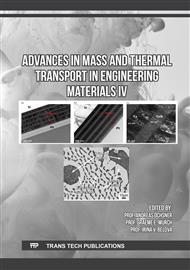[1]
V.P. Tarasov, S.V. Krivenko, G.G. Bozhkov. Properties of agglomerates of different basicity, Steel, 1 (2015), 2-5.
Google Scholar
[2]
A.N. Dmitriev, E.A. Vyaznikova, G.Yu. Vitkina, R.V. Alektorov, Study of the strength characteristics of agglomerate depending on its structure and phase composition, Defect and Diffusion Forum, 420 (2022), 63-72.
DOI: 10.4028/p-0g7e07
Google Scholar
[3]
St. Nicol, J. Chen, M.I. Pownceby, N.A.S. Webster, A review of the chemistry, structure and formation conditions of silico-ferrite of calcium and aluminum ('SFCA') phases, ISIJ International, 58-12 (2018), 2157-2172.
DOI: 10.2355/isijinternational.isijint-2018-203
Google Scholar
[4]
Y.E. Burova, E.A. Vyaznikova, A.N. Dmitriev, G.Y. Vitkina, R.V. Alektorov, G.A. Nechkin, V.V. Kataev, Study of change in strength properties of agglomerate depending on its structure and phase composition, Proceedings of X All-Russian Scientific-Practical Conference of Students, Postgraduate Students and Young Scientists "Thermal Engineering and Informatics in Education, Science and Production" with international participation", 2022, 59-64.
DOI: 10.4028/p-0g7e07
Google Scholar
[5]
E.A. Vyaznikova, A.N. Dmitriev, G.Yu. Vitkina, L.B. Vedmid, Study of formation of structural components of iron-ore agglomerates of different basicity at heating, Ferrous Metallurgy. Bulletin of scientific, technical and economic information, 11 (2022), 935-942.
Google Scholar
[6]
N.A.S. Webster, M.I. Pownceby, I.C. Madsen, A.J. Studer, Fundamentals of silico-ferrite of calcium and aluminum (SFCA) and SFCA-I iron ore sinter bonding phase formation: effects of CaO: SiO2 ratio, Metallurgical and Materials Transactions B, 45-6 (2014), 2097-2105.
DOI: 10.1007/s11663-014-0137-5
Google Scholar
[7]
T.Ya. Malysheva, R.M. Pavlov, The influence of the mineralogical composition of ligaments on the strength properties of agglomerates of various basicity, Izvestiya vuzov. Chernaya metallurgiya, 55-11 (2015), 6-10.
DOI: 10.17073/0368-0797-2012-11-6-10
Google Scholar
[8]
N.A.S. Webster, M.I. Pownceby, J.R. Manuel, R. Pattel, J.A. Kimpton, Fundamentals of silico-ferrite of calcium and aluminum (SFCA) and SFCA-I iron ore sinter bonding phase formation: effects of MgO on phase formation during heating, JOM, 73 (2021), 299-305.
DOI: 10.1007/s11837-020-04430-y
Google Scholar
[9]
V.Y. Lyadova, L.Z. Khodak, Method of production of fluxed iron ore sinter, Patent 2048548 C 22 B 1/16, Institute of Metallurgy named A.A. Baykov, Russian Academy of Sciences, 1995.
Google Scholar
[10]
V. Novák, L. Řeháčková, P. Klus, B. Smetana, S. Rosypalová, L. Drozdová, J. Dobrovská, Experimental study of thermoplastic properties of agglomerate, Proceedings 29th International Conference on Metallurgy and Materials, Brno, Czech Republic, EU, May 20 - 22, 2020.
DOI: 10.37904/metal.2020.3449
Google Scholar
[11]
M. Guha, M. Sinha, Tracking softening-melting behavior of blast furnace burden, ISIJ International, 55, 9 (2015), 2033-2035.
DOI: 10.2355/isijinternational.isijint-2014-621
Google Scholar
[12]
T. Nishimura, K. Higuchi, M. Naito, K. Kunitomo, Evaluation of softening, shrinking and melting reduction behavior of raw materials for blast furnace, ISIJ International, 51, 8 (2011), 1316-1321.
DOI: 10.2355/isijinternational.51.1316
Google Scholar
[13]
C.E. Loo, L.T. Matthews, D.P. O'dea, Lump Ore and Sinter Behaviour during Softening and Melting, ISIJ International, 51, 6 (2011), 930-938.
DOI: 10.2355/isijinternational.51.930
Google Scholar
[14]
M. Matsumura, M. Hoshi, T. Kawaguchi, Improvement of Sinter Softening Property and Reducibility by Controlling Chemical Compositions, ISIJ International, 45, 4(2005), 594-602.
DOI: 10.2355/isijinternational.45.594
Google Scholar
[15]
V. Shatokha, O. Velychko, Study of Softening and Melting Behaviour of Iron Ore Sinter and Pellets, High Temperature Materials and Processes, 31 (2012), 215-220.
DOI: 10.1515/htmp-2012-0027
Google Scholar
[16]
M.M. Hoque, H. Doostmohammadi, S. Mitra, D. O'dea, X. Liu, T. Honeyands, High Temperature Softening and Melting Interactions Between Newman Blend Lump and Sinter, ISIJ International, 61,12 (2021), 2944-2952.
DOI: 10.2355/isijinternational.isijint-2021-198
Google Scholar
[17]
G. Wang, J. Kang, J. Zhang, Y. Wang, Zh. Wang, Zh. Liu, Ch. Xu, Softening-melting behavior of mixed burden based on low-magnesium sinter and fluxed pellets, International Journal of Minerals, Metallurgy and Materials, 28 (2021), 621-628.
DOI: 10.1007/s12613-020-2047-7
Google Scholar
[18]
T. Li, Ch. Sun, X. Liu, S. Song, Q. Wang, The effects of MgO and Al2O3 behaviours on softening-melting properties of high basicity sinter, Ironmaking & Steelmaking, Processes, Products and Applications, 45,8 (2018), 755-763.
DOI: 10.1080/03019233.2017.1337263
Google Scholar
[19]
D.N. Togobitskaya, A.F. Khamkhotko, N.A. Gladkov, N.E. Khodotova, Development of models for prediction of aggregate transformation of iron ore materials in blast furnace, Fundamental and applied problems of iron and steel industry, 19 (2009), 49-67.
Google Scholar
[20]
A.N. Dmitriev, G.Yu. Vitkina, Yu.A. Chesnokov, Methodical basis of investigation of influence of the iron ore materials and coke metallurgical characteristics on the blast furnace smelting efficiency, Advanced Materials Research, 602-604 (2013), 365-375.
DOI: 10.4028/www.scientific.net/amr.602-604.365
Google Scholar
[21]
S.A. Gavrilko, A.A. Kiselev, G.A. Gromak, N.V. Lichkonenko, Y.V. Moisenko, V.M. Pechennikova, Y.S. Gavrilko, Study of softening of reduced sinter of various fractions, Metallurgy: collection of scientific papers ZGIA, 20 (2009), 26-31.
Google Scholar
[22]
E.V. Prikhodko, The role of chemical composition of iron ore materials in the formation of their metallurgical properties, Preparation of raw materials for metallurgical conversion and pig iron production, Chermetinformatsiya, Moscow, 5 (1987), 1-25.
Google Scholar
[23]
G.Yu. Vitkina, A.N. Dmitriev, E.A. Vyaznikova, R.V. Alektorov, The relationship between the composition, structure and metallurgical characteristics of iron ore agglomerates, AIP Conference Proceedings, 2456 (2022), 020062.
DOI: 10.1063/5.0074601
Google Scholar
[24]
A.N. Dmitriev, Yu.A. Chesnokov, G.Yu. Arzhadeeva, The Reducibility of the Iron Ore Materials as Instrument of the Coke Consumption Decrease in the Blast Furnace Smelting, Defect and Diffusion Forum, 334-335 (2013), 375-380.
DOI: 10.4028/www.scientific.net/ddf.334-335.375
Google Scholar


